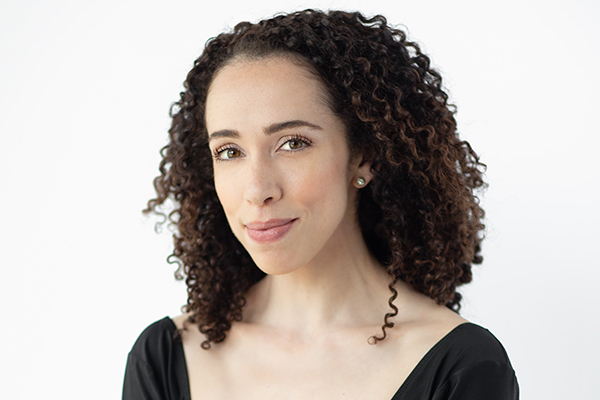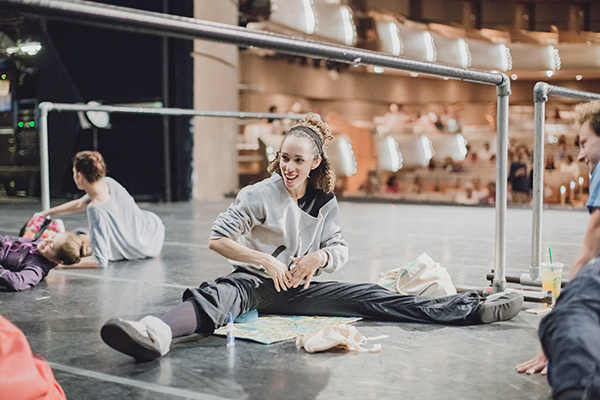Ballet
Nouvelles+
Taking the Lead on Important Conversations
Q&A with Jordana Daumec
11 février 2021

In the summer of 2020, when the Black Lives Matter movement gained an increased level of prominence amid renewed cries for racial justice, The National Ballet of Canada and the ballet world were also faced with a re-ignited anti-racist and cultural reckoning. At this time, First Soloist Jordana Daumec felt compelled to start discussing these issues more seriously within the company and to take a lead role in having difficult conversations with her fellow dancers. Jordana began facilitating a series of small group discussions to create a space for dancers to talk about the issues they face related to equity, diversity and inclusion.
Why did you want to be a part of facilitating these conversations with dancers about equity, diversity and inclusion?
I saw that a lot of dance companies had started posting messages after George Floyd’s death, which opened more people’s eyes to the issues that we as BIPOC people know are happening in the world at large as well as in the ballet world. In part, because we were all home because of COVID, we had a moment to step back and recognize that there’s a lot of things we can address in our own art circle. I wanted to give each dancer a safe, confidential space to talk freely and honestly about how they’re feeling about their experiences within The National Ballet of Canada and what we want to see for the company going forward.
I also wanted to use it as a constructive space for them to come up with ideas for what our roles can be in making changes within our company. It was also a chance for our non BIPOC dancers to step forward as allies and share ideas for how they can help.
Can you describe the general format and structure of the conversations?
The basic idea was to create a positive space for people to use their voices. I emailed everyone and found out who wanted to be involved and then I assembled small groups of individuals who would be comfortable talking with one another. I provided them with questions beforehand: what isn’t working, what does work, what do you want to see change, how do you want to see it change, do you feel like there’s enough representation, where would you like to see representation?
What were some of the rewards in facilitating these conversations?
Everyone was happy to have the space to be able to express themselves because we’ve never had a dancer only meeting to discuss these issues before. We do have the ability to tell the representatives on the Dancer Communications team what you would like to be raised with artistic staff and we have all-company town halls, but not everyone wants to put a hand up in those situations to bring issues forward. These intimate discussions gave each individual a chance to say what they’ve been wanting to say.
What were some of the challenges?
With 30 people participating, there was a lot of information and a lot of voices. I personally learned a lot about how to make a presentation for leadership staff and to condense the information because I originally wanted to include everyone’s voice and every comment. I also received guidance from CPAMO [Cultural Pluralism in the Arts Movement Ontario] and Theresa Ruth Howard, who helped me a lot with how to host these conversations and to be an advocate for people. They taught me how to represent the umbrella of the conversations without including every single detail when making my presentation.
What role do you think dancers have to play in changing the culture of their organizations and of the artform, to be more inclusive and respectful?
In any profession you may be afraid to say the wrong thing to the people who are holding your contract, but especially in the ballet world where the culture has always been to be seen but not heard. I think during COVID, with all the things that are happening in the United States and in Canada, we are finally saying that we should speak up and have a voice – and not just point fingers. I don’t think only pointing fingers is productive. Being productive is working together. We’re in this establishment together and we want to make our workplace better; we can’t just expect someone at the top to do all the work. All of us have to do the work.
What do you think the impact of holding conversations with your fellow dancers has been in the short term?
It made people feel heard. I think that is a huge first step; the feeling that someone hears and understands you and will pass your message along. It gives us hope that we’ll start making changes. There were a lot of similarities in where we want to see change. There were a lot of good ideas for how we can move forward, some of which the dancers can do and some ideas are for the organization to implement. For example, we really want to get out into the community more and do smaller shows apart from our performances at the Four Seasons Centre. We also really want to see representation throughout the whole building.
Were there any surprising outcomes for you?
As in any organization, people often talk behind the scenes, so much of what I heard didn’t surprise me. I was delighted by how many people wanted to participate and how invested they were.
Coming out of these conversations, are there particular blindspots that you found the company and the ballet world has when it comes to dancers’ experiences with discrimination?
I think that we can all be unaware of how the things that we say can be taken and felt by somebody else. You can say certain things and not realize that it might have a cultural implication for someone, be it religious or gender-based or having to do with sexuality or race. We all need to become more aware of the differences. And it’s not that we have to tip-toe around – it's just being aware and being inclusive. You might not know exactly how someone identifies or with what, so we just want to have a bigger frame of reference. And be in a place of learning and wanting to grow.

Do you have any advice for dancers or artists who may be interested in starting these kinds of conversations in their company, school or artistic community?
Do it. You have to take that leap and find that inner strength and know that other people do want to have these conversations. Don’t be scared, because that’s what stopped all of us from speaking up for so long. I was so scared to have these conversations before but when I took the leap, I realized that I didn’t need to be. Once you open up, you find your allies and from there you can keep building. I know the conversations can be uncomfortable, but you can even lead with the discomfort and say, “I feel a little uncomfortable saying this, but...” You want to say it in a constructive way. In life people often don’t listen if you come to the conversation with just accusations, so offering solutions helps the conversation. Theresa taught me to lead with facts and then tell people how it makes you feel.
What are your hopes for the next steps in the company’s journey to incorporate the principles of equity, diversity, inclusion and pluralism into every aspect of its operations?
I'm hoping that the EDI Task Force really can move forward to implement our ideas. I think that we can create a structure that each department can use and a source of information that can function as common knowledge for the company when dealing with issues of equity, diversity and inclusion. It’s going to take time. We’ve all done so much work so far and there’s still so much to be done. I hope that we don’t lose that fire to keep it going when it’s not in the news as much.
Theresa Ruth Howard and I are hosting another round of conversations with the dancers. Theresa is a former dancer and is amazing at speaking to cultural issues in ballet. I think that by having Theresa and Charles [Smith] and Kevin [A. Ormsby] from CPAMO on our team, our company is able to make these big changes and be a diversity leader in the ballet world. There are issues that have been going on since ballet has started, but I’m proud of where our company is right now and the trajectory of where we’re going. It probably isn’t all going to change while I’m still dancing, but it’s good to know that we’re laying the foundation for future generations.
Jordana Daumec est parrainée par un donneur anonyme par l’entremise de Dancers First.
Photos:
Jordana Daumec. Jordana Daumec at Class on Stage. Photos by Karolina Kuras.
